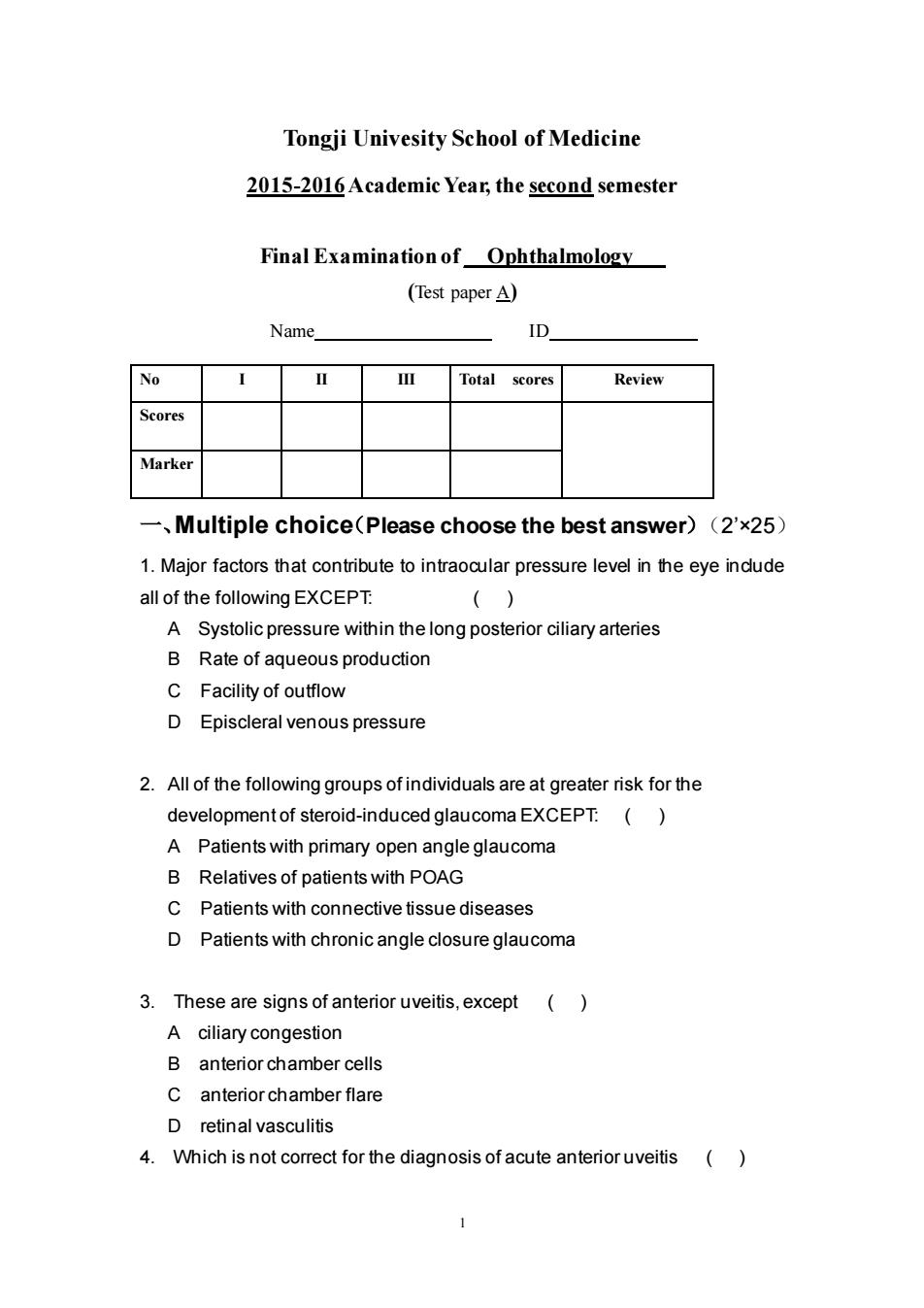
Tongji Univesity School of Medicine 2015-2016Academic Year,the second semester Final Examination of Ophthalmology (Test paper△) Name_ D No Ⅲ Total scores Review Scores Marke 一、Multiple choice(Please choose the best answer)(2'×25) 1.Major factors that contribute to intraocular pressure level in the eye indude all of the following EXCEPT: A Systolic pressure within the long posterior ciliary arteries B Rate of aqueous production C Facility of outflow D Episcleral venous pressure 2.All of the following groups of individuals are at greater risk for the development of steroid-induced glaucoma EXCEPT:( A Patients with primary open angle glaucoma B Relatives of patients with POAG C Patients with connective tissue diseases D Patients with chronic angle closure glaucoma 3.These are signs of anterior uveitis,except ( A ciliary congestion B anterior chamber cells C anterior chamber flare D retinal vasculitis 4.Which is not correct for the diagnosis of acute anterior uveitis
1 Tongji Univesity School of Medicine 2015-2016Academic Year, the second semester Final Examination of __Ophthalmology___ (Test paper A) Name ID No I II III Total scores Review Scores Marker 一、Multiple choice(Please choose the best answer)(2’×25) 1. Major factors that contribute to intraocular pressure level in the eye include all of the following EXCEPT: ( ) A Systolic pressure within the long posterior ciliary arteries B Rate of aqueous production C Facility of outflow D Episcleral venous pressure 2. All of the following groups of individuals are at greater risk for the development of steroid-induced glaucoma EXCEPT: ( ) A Patients with primary open angle glaucoma B Relatives of patients with POAG C Patients with connective tissue diseases D Patients with chronic angle closure glaucoma 3. These are signs of anterior uveitis, except ( ) A ciliary congestion B anterior chamber cells C anterior chamber flare D retinal vasculitis 4. Which is not correct for the diagnosis of acute anterior uveitis ( )
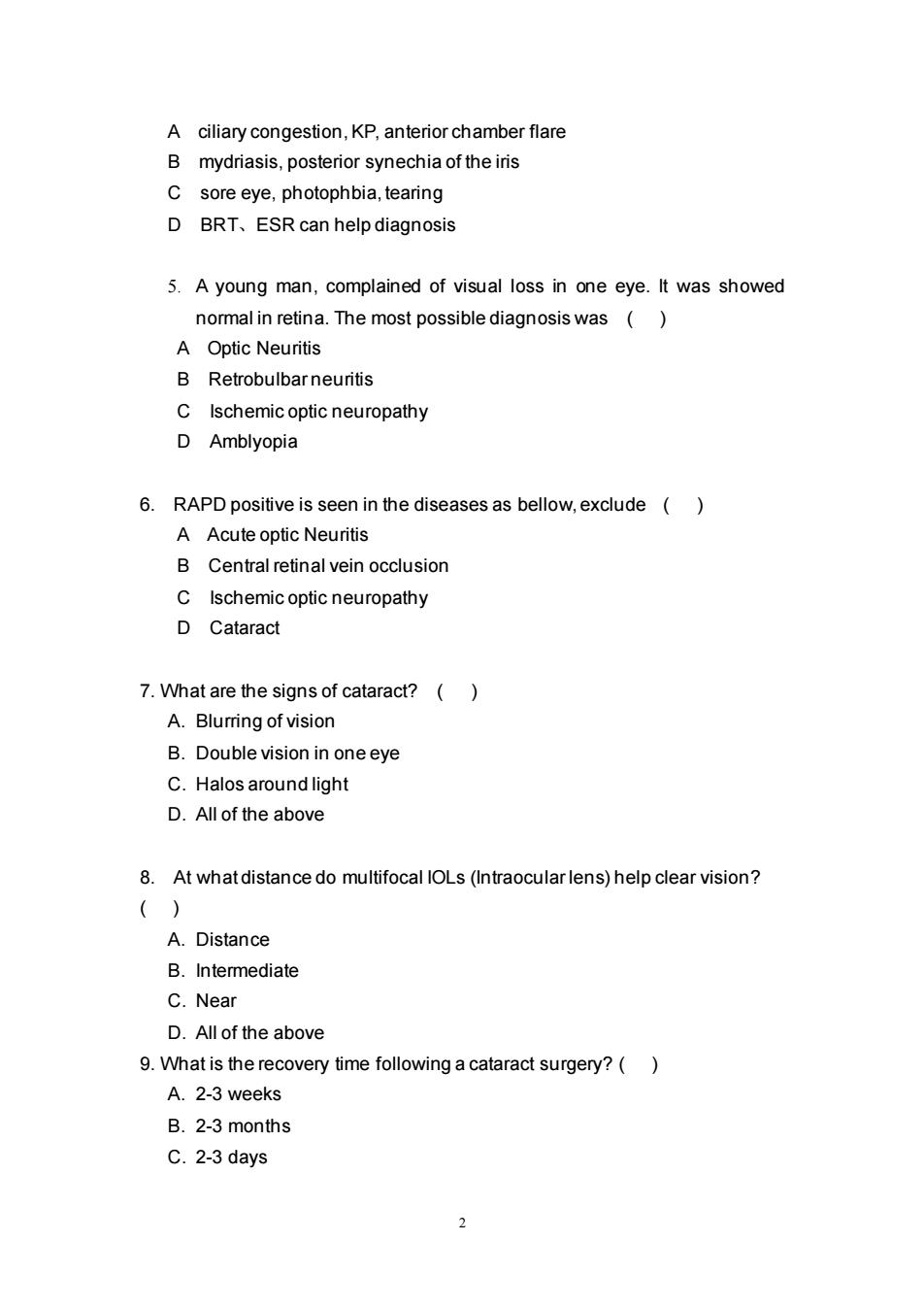
A ciliary congestion.KP.anterior chamber flare B mydriasis,posterior synechia of theiris C sore eye,photophbia,tearing D BRT,ESR can help diagnosis 5.A young man,complained of visual loss in one eye.It was showed normal in retina.The most possible diagnosis was A Optic Neuritis B Retrobulbarneuritis C Ischemic optic neuropathy D Amblyopia 6.RAPD positive is seen in the diseases as bellow,exclude ( A Acute optic Neuritis B Central retinal vein occlusion C Ischemic optic neuropathy D Cataract 7.What are the signs of cataract?( A.Blurring of vision B.Double vision in one eye C.Halos around light D.All of the above 8.At what distance do multifocal IOLs(Intraocular lens)help clear vision? () A.Distance B.Intermediate C.Near D.All of the above 9.What is the recovery time following a cataract surgery?( A.2-3 weeks B.2-3 months C.2-3 days
2 A ciliary congestion, KP, anterior chamber flare B mydriasis, posterior synechia of the iris C sore eye, photophbia, tearing D BRT、ESR can help diagnosis 5. A young man, complained of visual loss in one eye. It was showed normal in retina. The most possible diagnosis was ( ) A Optic Neuritis B Retrobulbar neuritis C Ischemic optic neuropathy D Amblyopia 6. RAPD positive is seen in the diseases as bellow, exclude ( ) A Acute optic Neuritis B Central retinal vein occlusion C Ischemic optic neuropathy D Cataract 7. What are the signs of cataract? ( ) A. Blurring of vision B. Double vision in one eye C. Halos around light D. All of the above 8. At what distance do multifocal IOLs (Intraocular lens) help clear vision? ( ) A. Distance B. Intermediate C. Near D. All of the above 9. What is the recovery time following a cataract surgery? ( ) A. 2-3 weeks B. 2-3 months C. 2-3 days
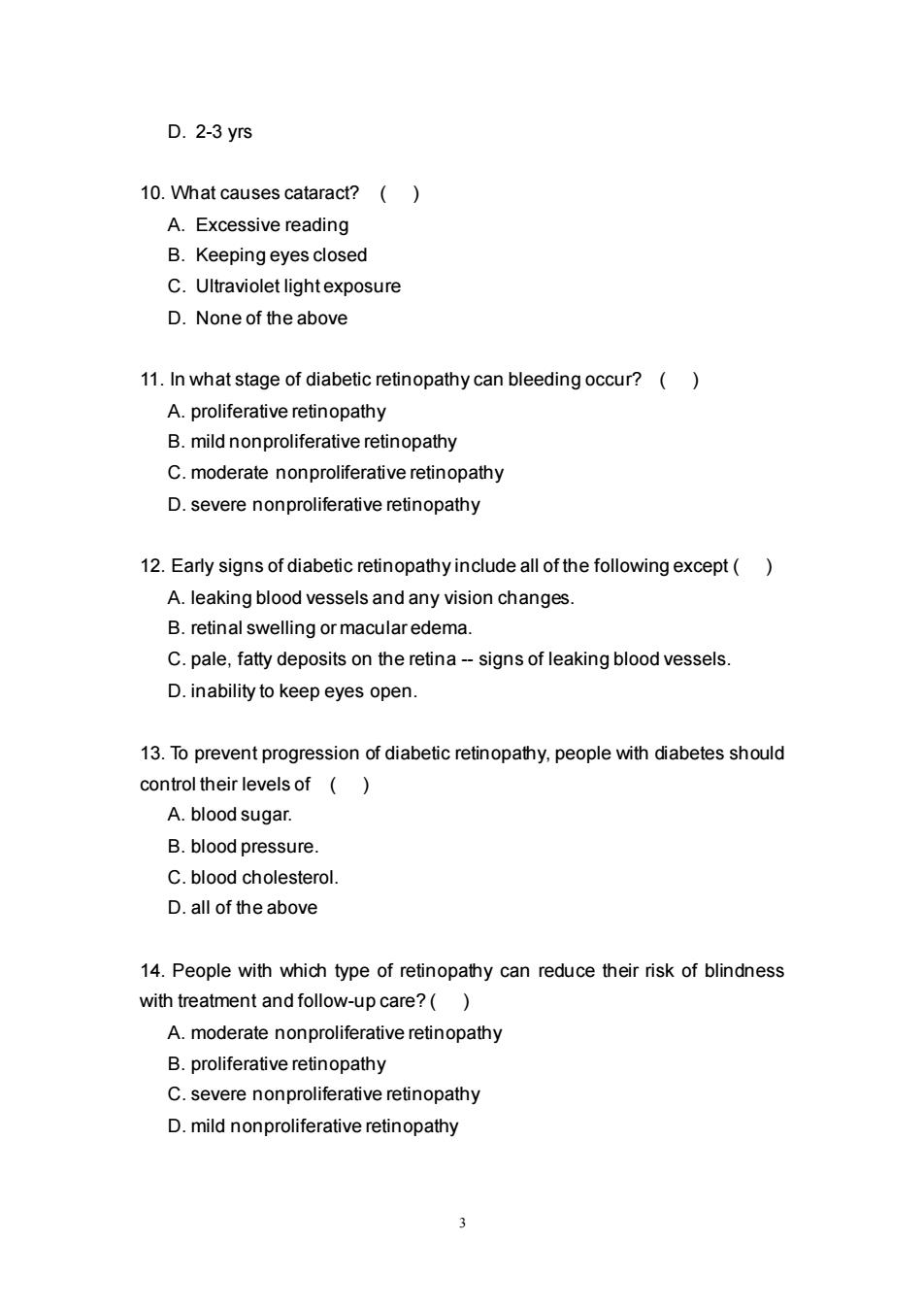
D.2-3 yrs 10.What causes cataract?( A.Excessive reading B.Keeping eyes closed C.Ultraviolet lightexposure D.None of the above 11.In what stage of diabetic retinopathy can bleeding occur?( A.proliferative retinopathy B.mild nonproliferative retinopathy C.moderate nonproliferative retinopathy D.severe nonproliferative retinopathy 12.Early signs of diabetic retinopathy include all of the following except() A.leaking blood vessels and any vision changes. B.retinal swelling or macularedema. C.pale,fatty deposits on the retina--signs of leaking blood vessels. D.inability to keep eyes open. 13.To prevent progression of diabetic retinopathy,people with diabetes should control their levels of ( A.blood sugar. B.blood pressure C.blood cholesterol. D.all of the above 14.People with which type of retinopathy can reduce their risk of blindness with treatment and follow-up care?( A.moderate nonproliferative retinopathy B.proliferative retinopathy C.severe nonproliferative retinopathy D.mild nonproliferative retinopathy
3 D. 2-3 yrs 10. What causes cataract? ( ) A. Excessive reading B. Keeping eyes closed C. Ultraviolet light exposure D. None of the above 11. In what stage of diabetic retinopathy can bleeding occur? ( ) A. proliferative retinopathy B. mild nonproliferative retinopathy C. moderate nonproliferative retinopathy D. severe nonproliferative retinopathy 12. Early signs of diabetic retinopathy include all of the following except ( ) A. leaking blood vessels and any vision changes. B. retinal swelling or macular edema. C. pale, fatty deposits on the retina -- signs of leaking blood vessels. D. inability to keep eyes open. 13. To prevent progression of diabetic retinopathy, people with diabetes should control their levels of ( ) A. blood sugar. B. blood pressure. C. blood cholesterol. D. all of the above 14. People with which type of retinopathy can reduce their risk of blindness with treatment and follow-up care? ( ) A. moderate nonproliferative retinopathy B. proliferative retinopathy C. severe nonproliferative retinopathy D. mild nonproliferative retinopathy
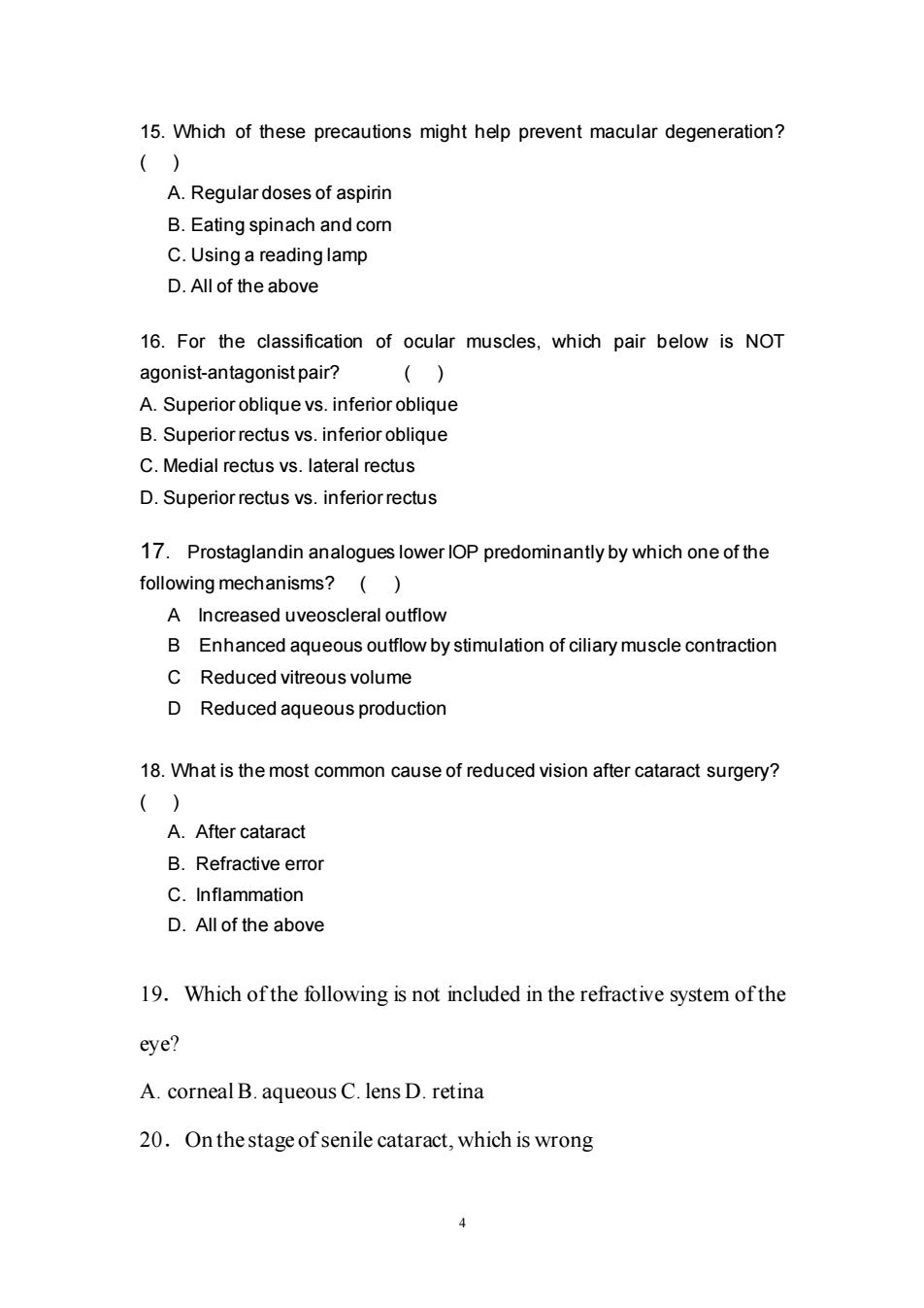
15.Which of these precautions might help prevent macular degeneration? () A.Regulardoses of aspirin B.Eating spinach and com C.Using a reading lamp D.All of the above 16.For the classification of ocular muscles,which pair below is NOT agonist-antagonist pair? A.Superior oblique vs.inferior oblique B.Superior rectus vs.inferior oblique C.Medial rectus vs.lateral rectus D.Superior rectus vs.inferior rectus 17.Prostaglandin analogues lower IOP predominantly by which one of the following mechanisms?( A Increased uveoscleral outflow B Enhanced aqueous outflow by stimulation of ciliary muscle contraction C Reduced vitreous volume D Reduced aqueous production 18.What is the most common cause of reduced vision after cataract surgery? () A.After cataract B.Refractive error C.Inflammation D.All of the above 19.Which of the following is not included in the refractive system of the eye? A.corneal B.aqueous C.lens D.retina 20.Onthestage of senile cataract,which is wrong 4
4 15. Which of these precautions might help prevent macular degeneration? ( ) A. Regular doses of aspirin B. Eating spinach and corn C. Using a reading lamp D. All of the above 16. For the classification of ocular muscles, which pair below is NOT agonist-antagonist pair? ( ) A. Superior oblique vs. inferior oblique B. Superior rectus vs. inferior oblique C. Medial rectus vs. lateral rectus D. Superior rectus vs. inferior rectus 17. Prostaglandin analogues lower IOP predominantly by which one of the following mechanisms? ( ) A Increased uveoscleral outflow B Enhanced aqueous outflow by stimulation of ciliary muscle contraction C Reduced vitreous volume D Reduced aqueous production 18. What is the most common cause of reduced vision after cataract surgery? ( ) A. After cataract B. Refractive error C. Inflammation D. All of the above 19.Which of the following is not included in the refractive system of the eye? A. corneal B. aqueous C. lens D. retina 20.On the stage of senile cataract, which is wrong
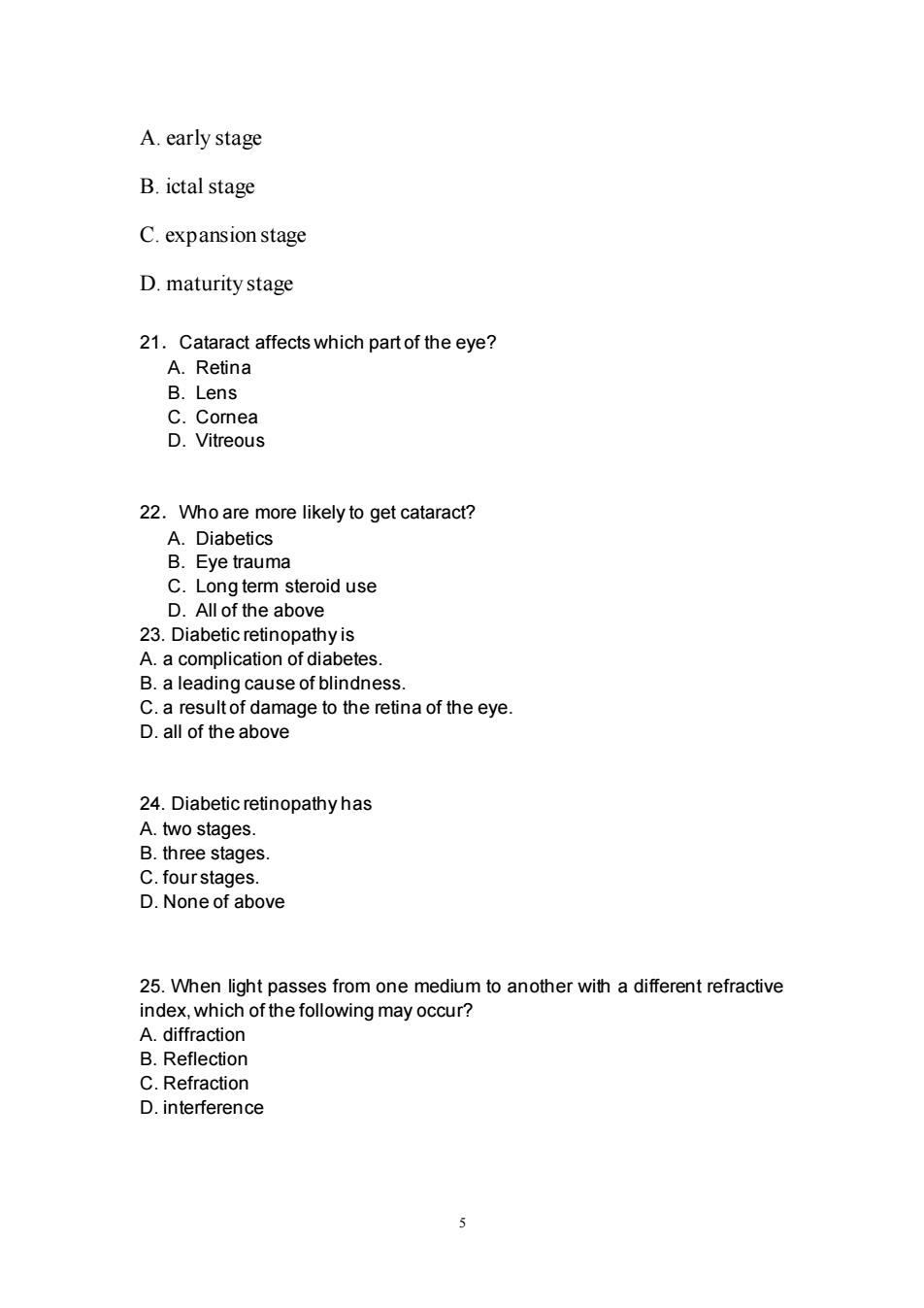
A.early stage B.ictal stage C.expansion stage D.maturity stage 21.Cataract affects which partof the eye? A.Retina B.Lens C.Comea D.Vitreous 22.Who are more likely to get cataract? 合 C.Long term steroid use D.All of the above 23.Diabetic retinopathy is A.a complication of diabetes of damage to the reina of the ey dness D.all of the above 24.Diabetic retinopathy has A.two stages. B.three stages C.fourstages. D.None of above 25.When light passes from one medium to another with a different refractive index,which of the following may occur? A.diffraction B Reflection C.Refraction D.interference
5 A. early stage B. ictal stage C. expansion stage D. maturity stage 21.Cataract affects which part of the eye? A. Retina B. Lens C. Cornea D. Vitreous 22.Who are more likely to get cataract? A. Diabetics B. Eye trauma C. Long term steroid use D. All of the above 23. Diabetic retinopathy is A. a complication of diabetes. B. a leading cause of blindness. C. a result of damage to the retina of the eye. D. all of the above 24. Diabetic retinopathy has A. two stages. B. three stages. C. four stages. D. None of above 25. When light passes from one medium to another with a different refractive index, which of the following may occur? A. diffraction B. Reflection C. Refraction D. interference

二、Explanation question(5'×4) 1.Cataract 2.ocularsurfacediseases 3.Glaucoma 4.Ductions 三、Essay question 1.Describe the clinical features and management of penetrating injury of eye.(15)
6 二、Explanation question (5’×4) 1. Cataract 2. ocular surface diseases 3. Glaucoma 4. Ductions 三、Essay question 1. Describe the clinical features and management of penetrating injury of eye. (15’)

2.What is the management of acute angle closure?(15')
7 2. What is the management of acute angle closure? (15’)